DaviSound TB-6 "WG"
New Layout Styling 2006
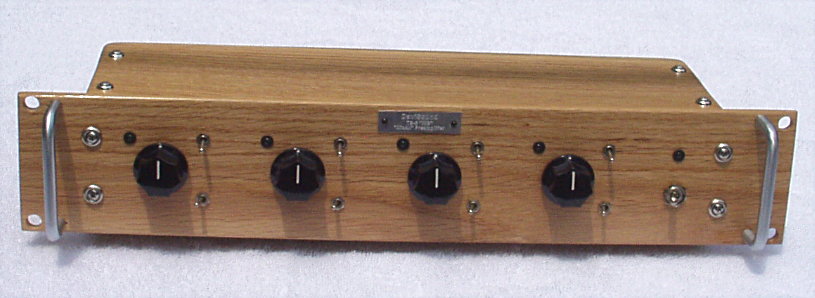
As of May, 2006, in keeping with our "WG" styling enhancements ...
The popular TB-6 standard Tool Box was also modified just slightly.
The control area was grouped a bit tighter between channels ...
while the
individual channel area was slightly enlarged to accomodate larger knob styles.
Actual, specific knob styles may vary according to availability or by special order.
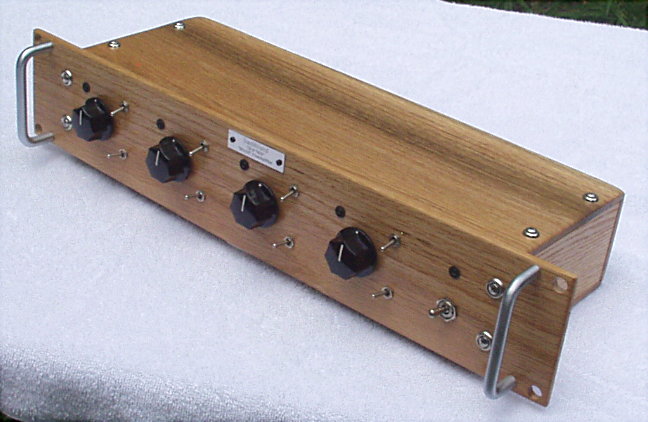
This inaugural version is housed in our traditional American Red Oak cabinetry ...
these pieces being select, spalted wood stock.

The phase reverse switch was moved from the lower center to the lower right.
This layout easily facilitates often requested front panel instrument input jacks ...
which can be added to the lower left on custom models.
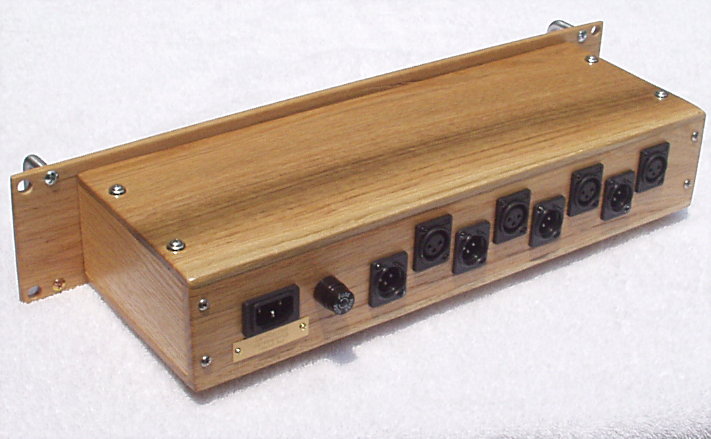
Input/Output pairs are from right to left with channel one to the far right ...
directly behind its corresponding front panel control.
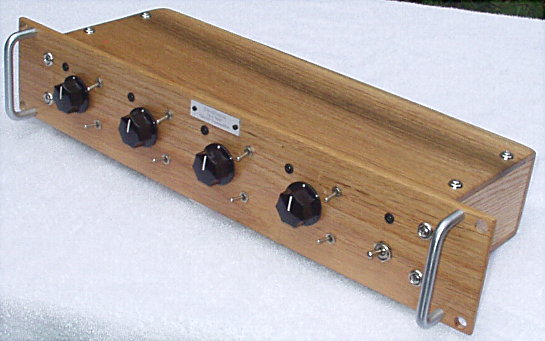
The DaviSound TB-6 Four Channel "Mic-All" Preamp Package
Layout as of 2006
Exotic Woods Available By Special Order
And then ... a customized "mate" ...
a special ordered version with front panel instrument/line
Inputs ....
This angle showcases the beautiful Spalted Oak grain patterns of this cabinet.
Actual knob styles for the TB-6 may vary ...
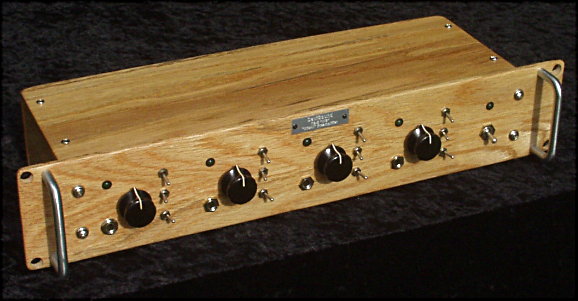
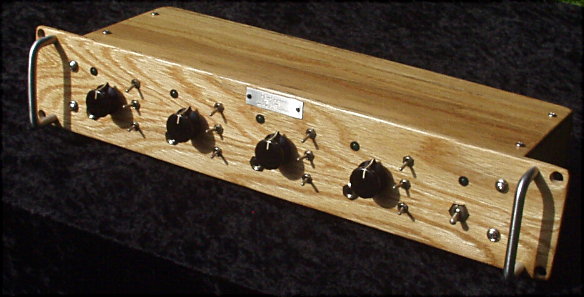
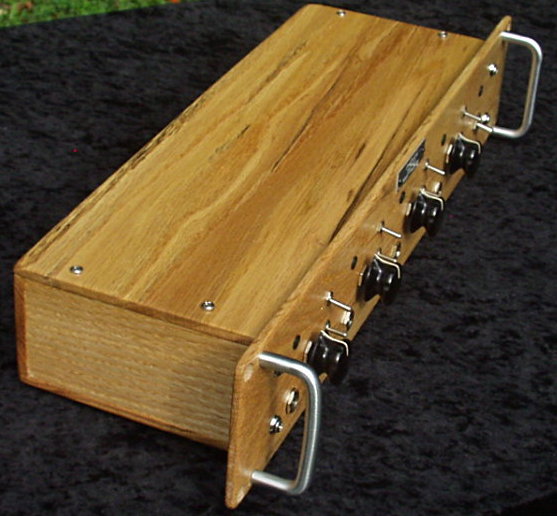

The knobs shown in the photo above are vintage, NOS, RCA supplied by the client.
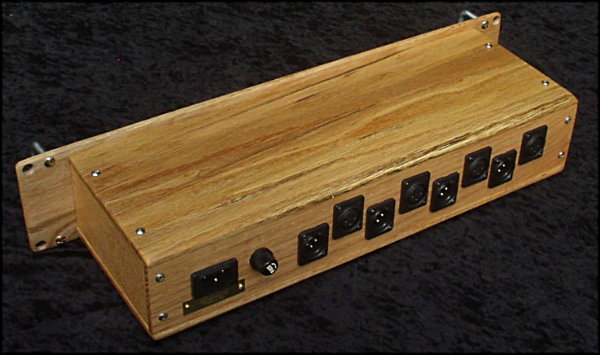
The DaviSound TB-6 is a package of "Mic-All" Microphone preamplifiers incorporating the custom DS House IC Op Amp in a special transformerless, differential configuration.
The TB-6 package provides separate phantom power switching to each amplifier individually with a separate indicator LED for each also.
Originally, the design also provided an over-all Master Phantom Switch. However, this redundant function has recently been omitted since it was considered a subtle improvement to eliminate the overall "Bus Feed" method of phantom power routing and, instead, utilize the separate switches in conjunction with isolated feeds from within each individual channel.
One of the most unique features of the DS MIC-ALL design is the fully variable active gain control which is panel mounted and provides fully variable gain of the second stage of each amplifier. When the active gain control is set for the right amount of gain for the incoming signal, the amplifier is operating with the exact, correct gain structure for that signal and optimum headroom and signal to noise ratio is automatically assured.
That being the case, no "padding" of the input signal is ever necessary and noisy pads are rendered obsolete by this design.
The fully ACTIVE gain control provides just the right amount of amplification/dynamic range for the input signal when set as required by the incoming source level.
DaviSound Tool Boxes employ active differential input balancing and ground referenced "quasi-balanced" low impedance outputs.
In keeping with today's standards, XLR pins are arranged as follows: 1=Ground 2=Hi 3= Lo
The XLR outputs on all Tool Boxes offer BOTH balanced and unbalanced capabilities as follows:
IMPORTANT NOTE:
While the input stages of the Mic-All amplifiers are diode clamp protected against voltage spikes, it is good practice to turn on the phantom power, or turn off the phantom power, ONLY when a microphone is connected to the input! Phantom power switching can cause high voltage spikes which are not desirable for the input stages to "process".
Maintaining the microphone load during switching avoids this possibilty. Also, to protect microphones from undue "arcing", it is not good practice to plug them into, or unplug them from, phantom powered equipment until the power has been switched off!
Actual internal impedance is 2KOhms balanced for optimum voltage transfer of all low impedance professional microphones from 50 ohms impedance to 600 ohms impedance.
Actual output impedance is 100 ohms (47 ohms unbalanced) and the TB-6 "Mic-All" amplifiers will drive virtually any line load from 600 ohms to high impedance bridging!
The layout and operation for this unit is simple, straightforward and, thus, "operator friendly".

NEW TB-6 CONTROL PANEL LAYOUT AS OF SUMMER 2006
There are four hardware functions on the front panel for each channel. The vertical action phantom power switch with associated LED "on" indicator are located at the top of the Gain Control. The horizontally mounted switch located beneath the gain control is the PHASE REVERSE switch with left/right toggle operation.
As with most current DaviSound designs, panel labeling/lettering is kept to an absolute minimum since we believe it enhances the aesthetic appeal and inetegrity of a piece of professional equipment to avoid redundant markings and panel clutter! The TB-6 functions are self-indicating to the professional user without any type of markings being either necessary or desirable!
The left/right toggle handle position phase reverse action of the respective phase switches is all relative of course but the LEFT toggle position corresponds with input pins 2 & 3 to output pins 2 & 3, whereas the RIGHT position reverses the polarity of input pins 2 & 3.
Approximate gain control settings, as determined by the white pointer on the control knob are as follows:
REAR PANEL LAYOUT:

As with many professional rack mount units, the rear panel connectors correspond directly adjacent across
to the front panel,
which means, associated connectors for the channels one through four run from RIGHT to LEFT
on the rear panel.
The first jacks at the far right are for channel 1 with the suceeding jacks in numerical order-right to left.
FEMALE XLR connectors are for the inputs and MALE XLR connectors are for the outputs.
The AC power cord IEC EMI FILTER RECEPTACLE and FUSE HOLDER are at the far left of the rear panel.
PERFORMANCE -
Performance "DaviSpecs" Specifications
Unless specifically stated otherwise in individual descriptions ...
and for all Tool Boxes which employ our "MP-2 MasterPiece" circuit module, which is nicknamed the "Mic-All", for the complete signal chain gain block, the electrical specifications are as follows:
ALL amplifiers feature ruler flat frequency response ...
with -3dB points at 1.6 HZ and 35 KHz (maximum gain). There is a slightly variable HF bandwidth increase as gain is actively decreased to unity or below
(flat to 70KHz at unity).
This is because an active filtering configuration is employed to intentionally rolloff extreme high frequency response to minimize RF / EMI out of band interference, noise contribution, and intermodulation distortions.
Combined distortions specifications are where the DaviSound "MIC-ALL" amplifiers REALLY outperform most all others anywhere! There is virtually NO measurable distortion at any level or frequency until maximum gain settings are utilized. Even then, the measurements are near the residuals of the test instruments and barely detectable at the frequency extremes- (.008% at 20 KHZ, +55dB gain)!
Under more reallistic gain settings, amplifier distortion is even lower (example: typically .001%, 1KHZ, 40dB gain ... immeasurable at gain settings below 40 db [theoretically, mathematically indicated better than .0008%] )!
This performance characteristic is responsible for claim after claim from virtually ALL awe inspired users that our amp is the "cleanest" they have ever heard!
One of the most crucial parameters in microphone signal handling is HEADROOM. The MIC-ALL amps are relatively unsurpassed in this regard with signal handling capability right up near +32 dBU before clipping! We acheive this with our House IC and thermal protection which allows a much higher power supply voltage than most conventional designs. This provides a full 8 to 10 dB more headroom than many other professional designs on the market today!
Keep in mind, that output level offered by an output boosted stage does NOT always correspond to system headroom throughout! Some other units boast an output of +36 dB, or more, that do NOT offer that headroom throughout their chain. DaviSound specs are through chain, input to output.
EIN Unweighted -122dB 100 ohms
Noise 20Hz to 20KHz Unweighted - 98dB
Actual internal impedance is 2KOhms, differentially balanced for optimum voltage transfer of all low impedance professional microphones from 50 ohms impedance to 600 ohms impedance.
Actual output impedance is 100 ohms (47 ohms unbalanced) and the high current "Mic-All" output stages will drive virtually any line load from 600 ohms to high impedance bridging with no increase in distortion or any other loading effect!
ELECTRICAL SPECIFICATIONS FOR DAVISOUND HOUSE IC USED IN "MIC-ALL" MP-2 "MasterPiece" Modules |
The inherent specifications of the House IC itself are actually further enhanced in our actual audio application by our circuit design techniques within the MP-2 module!
One such technique ... which we believe has so much to do with the exceptional, noticable "accuracy of detail" comment that we hear so often from users in regard to the performance of our amplifiers ... is a unique inter-stage direct coupling/biasing scheme which forces the amplifier into near full Class-A operation. Any extra heat generated in this process is harmlessly dissapated in the thermally conductive epoxy ecasement of the sealed MP-2 module!
This, combined with the, overload proof, fully variable, active gain technique, produces results as close as you can get to a truly "distortionless" amplifier!
Generally speaking, in regard to most performance specifications, DaviSound Tool Boxes perform better than any of the state-of-the-art equipment that is currently available to test them! This is why we say they offer the quality reference by which to judge all others.
|
NOTE:
While the TB-6 offers up to near 60 dB of gain, keep in mind, as can be seen from the chart below, that such extreme settings are very seldom needed! Typical maximum studio mic preamp gain requirements are around 40 dB or less on the average.
Some interesting observations in regard to actual microphone output levels and, thus, resulting amplification requirements -
Here is an enlightening study, done some time ago, and published in Audio Amateur Magazine on several occasions (original- Russell Hamm - JAES 21:4 [May, 1973] ) in regard to audio signal levels measured direct FROM MICROPHONES.
Please note that the measured levels we are talking about here are STRAIGHT out of the microphones themselves with NO additional amplification!
This will surprise most all but the most experienced, veteran recording engineers since, in some cases as will be shown, you would not only NOT need ANY mic preamplification but might even need gain reduction!
Peak Mic levels 0dB ref to 0dBu=.775 volts
INSTRUMENT Distance in inches Neumann U-87 RCA-77DX EV-666
(Typical condenser) (Ribbon) (Dynamic)
Bass Drum 6 0 -9 -4
Large Tom Tom 12 -1 -9 -5
Small Tom Tom 12 -1 -7 -1
Piano (single note) 6 -25 -38 -32
Cow Bell 12 -10 -29 -15
Loud Yell 4 0 Not Tested -10
Notice that a loud yell (or similar loud vocal musical note!) into a typical condenser mic can produce an unamplified output of 0 dBU which is .775 volts RMS or about 2.2 volts peak to peak!
On the other hand, it is not uncommon to encounter, say with a "whispery" female vocalist into a ribbon mic, even as close as three inches, signals as low as -50 dBU or about 7 millivolts!
So, a microphone preamp has to, quite literally, deal with one extreme to another.
The MIC-ALL preamp can, as structured in the TB-6, typically output +28 dBu with some headroom.
However, if set for a gain of, say, 40 dB...it can be seem from the above examples that it would easily overload and distort with many of the microphone signals shown!
At that setting, a loud yell or vocal extreme into a condenser mic at about six inches could cause the amp to try and pass a +40dBu signal ...obviously at LEAST 12 db past the clipping point! Obviously, the higher you raise your "0 VU" operating level, the LOWER your headroom before the clipping stage!
That is the point of the INFINITELY VARIABLE GAIN CONTROL that allows you to continually "dial-in" just the right amount of gain for your incoming microphone signal!
GENERAL -
The rack cabinet itself is made from hand sculptured, natural, solid wood. As of spring 2001, we have opted for lustrous, hard penetrating oil finishes for the cabinetry as this provides added protection for the wood and, unlike other oil finishes, it is relatively maintenance free. Simply wipe it with a soft dry cloth to restore lustre.
WG Models are entirely made of wood! The front panel as well as the rest of the cabinet are ALL typically solid oak (unless other exotic woods have been utilized by client arrangement/preferance). Like all natural things, every piece of wood has its own, distinct character and "personality". This makes EACH AND EVERY "WG" model unique unto itself which enhances the aesthetic value of the piece and the actual appreciative monetary value as well!
Keep in mind that as part of this wood "character" it is impossible to find/utilize a "PERFECT" piece of wood. This means there may be slight imperfections, or variations, in terms of grain pattern, color uniformity, and skew. However, any such natural variations in our selected pieces are very minor and are the very thing that gives wood its charm and "character" appeal!
There are NO user servicable parts inside. DaviSound Tool Boxes are fashioned from our "Master Pieces" modules which employ hand-laid circuitry, silicon embedded into plastic cased modules. In the unlikely event that service should ever be required, simply contact us for return authorization and we will replace the defective module(s).
While never having been enforced, it was original DaviSound policy to void warranties if the cover is removed! However, certainly be advised that ANY internal tampering, or unauthorized repair or modification attempts, void all warranties!
DaviSound products are carefully assembled BY HAND, one piece at a time from start to finish,
in prototype assembly fashion, with extreme care and attention. They are designed to perform
from now on with no trouble.
However, there are always "real world" imperfections that can not be anticipated or accounted for no matter HOW careful one might be in fabrication. For example, we don't make the ICs and we don't wind the power transformers and these things can fail at times. Ours seldom do, due to extensive testing and pre shipment "burn-in" periods, but if you should ever have a problem, you are protected for as long as you own the equipment, as the original owner.
Simply carefully repack the unit in the original packing, ship it back to us (after notification) to
DaviSound, 1504 Sunset Ave., Newberry, SC 29108 803-276-0639
and we will repair and reship at no charge to you whatever!
Thank you for your purchase and use of a DaviSound Tool Box!
And, we also thank you for allowing us to go these "extra lengths" within YOUR operating manual to elaborate in accordance with our "mission" in publishing these on-line manuals. It is all part of an ongoing effort to provide as much educational material as possible from this website in the sincere belief that ...
The more one truly KNOWS about audio electronics, the more one can truly appreciate the DaviSound methods!
We thank all of you who ALREADY know all of this covered herein for your indulgence as we present it for those who do not!
Please let us hear from you regarding your application of our unit and feel free to contact us with any questions or comments throughout the future!
We also hope that you will consider ALL of the DaviSound Tool Box models for your rack!
THANK YOU and GOOD LUCK!